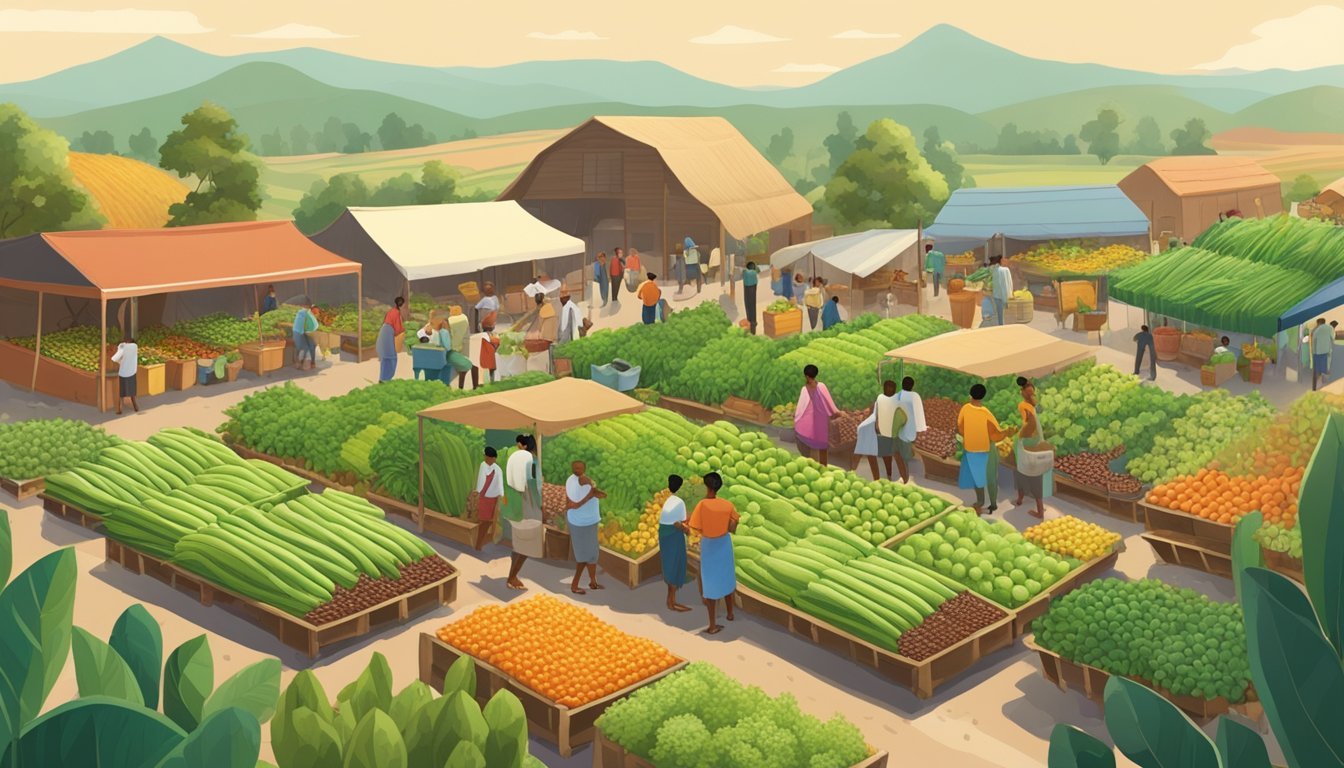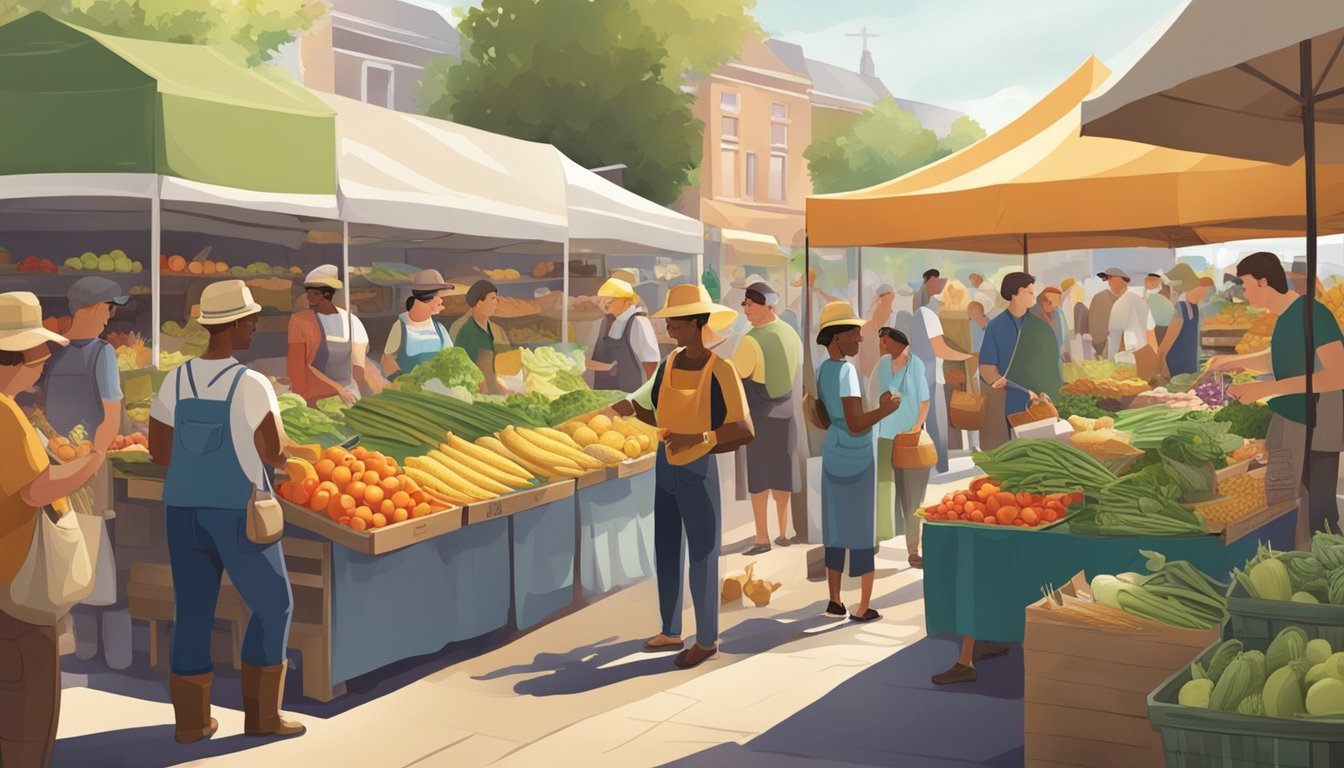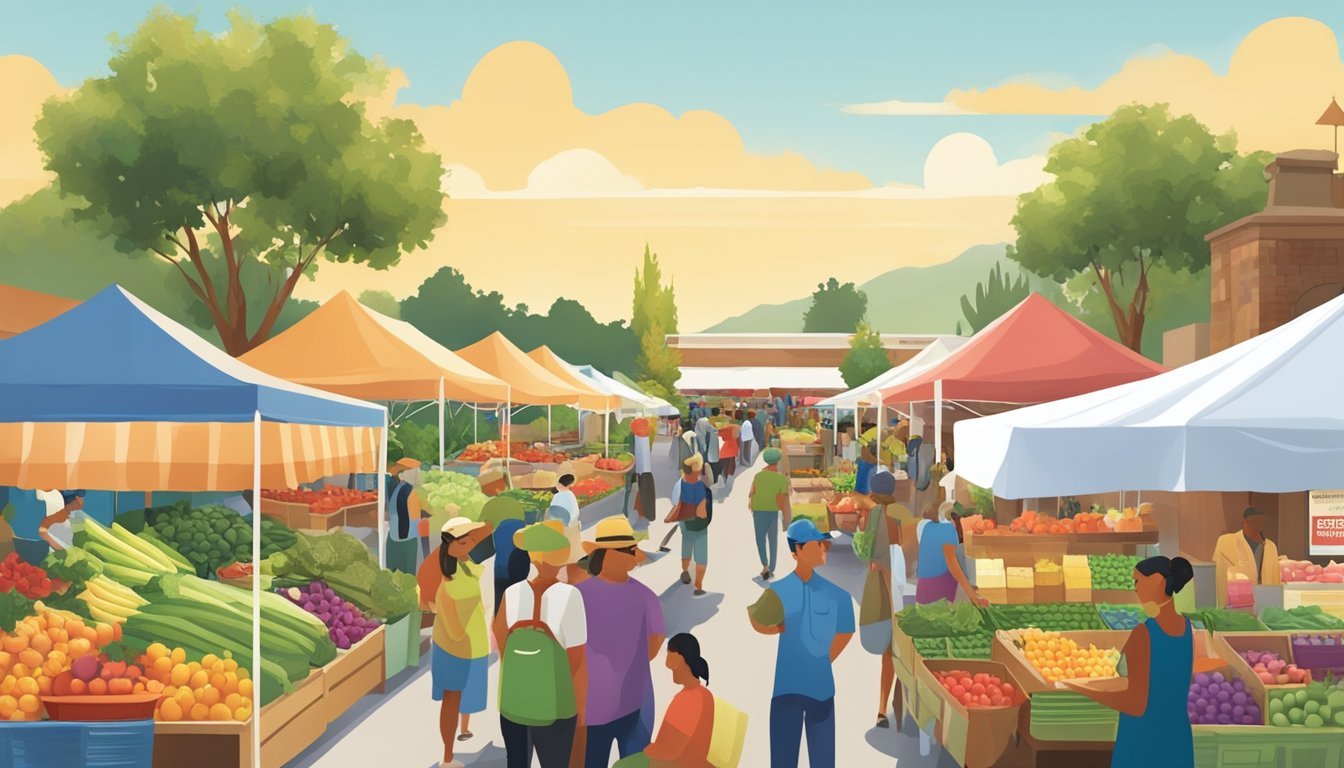Community Supported Agriculture in Anaheim, CA
Your Guide to Local CSAs
Community Supported Agriculture, abbreviated as CSA, is a popular system in which consumers purchase produce directly from local farmers, creating a symbiotic relationship between the two. In Anaheim, CA, the CSA model is flourishing, giving residents access to fresh, seasonal food while supporting the local agricultural community. By buying "shares" from participating farms, members receive regular deliveries or pickups of vegetables, fruits, and sometimes other farm products, depending on the offerings of the CSA.
The CSA model benefits both consumers and farmers. Residents of Anaheim enjoy produce that is fresher and often more flavorful than what is found in traditional retail settings because the goods travel a far shorter distance from farm to table. In turn, farmers gain a direct and reliable market for their harvests, financial support upfront, and a chance to build relationships with the people they feed. This model helps keep agricultural practices economically viable and fosters a greater sense of community around food.
In Anaheim, CSAs are not just a source of nourishment but a way to invest in the health and sustainability of the local community. Anaheim residents partake in CSAs for a variety of goods, supporting sustainable farming practices and the local economy. Participating in a CSA program often means participating in the seasonal rhythms of agriculture, with the selection of produce reflecting the natural growing cycles in California.
Understanding CSA
Community Supported Agriculture (CSA) is a model where individuals invest in local farms, receiving a portion of the crops and sharing in the farm's risk and bounty. This system fosters a closer connection between consumers and food producers.
CSA Program Fundamentals
CSA is built around the principle of individuals -- referred to as shareholders -- purchasing a "share" of the farm's produce. This share represents a portion of the expected harvest over the upcoming season. Shareholders typically receive regular deliveries of fresh, seasonal produce.
Payment is usually upfront, which provides the farmer with necessary funds before the season begins.
Participants share in the risks, such as weather impacts or crop failure.
Benefits of Community Supported Agriculture
Community Supported Agriculture benefits both the farmer and the community at large.
For farmers, receiving payment upfront eases the financial pressures of the growing season.
Community members gain access to fresh, often organic, produce which supports health.
This direct relationship boosts the local economy and strengthens the community.
Types of CSA Models
There are various models of CSA which cater to different preferences and needs:
Traditional CSA: Members get a set share of whatever the farm produces.
Market-Style CSA: Members choose the produce from a designated selection, similar to shopping at a farmers market.
Selecting the Right CSA
When choosing a CSA, individuals should consider:
The variety and types of crops grown.
The payment plans and scheduling flexibility.
Pick-up locations or delivery options.
Tips for selecting a CSA:
Research the farm's reputation and produce quality.
Ask questions directly to understand their CSA program particulars.
Challenges and Considerations
Participating in a CSA comes with certain responsibilities and challenges.
Shared risk: Understand that crop yield varies with weather and other factors.
Commitment: Be prepared for fluctuations in produce variety and quantity.
Support: Embrace the CSA as a long-term relationship with the farmer.
CSA in Anaheim, CA
In Anaheim, CA, residents have the opportunity to participate in Community Supported Agriculture, commonly known as CSA, to access fresh, locally-grown produce. Through this program, members support local farms with a seasonal investment, in return for a share of the harvest.
Local CSA Farms
Anaheim boasts a variety of CSA farms, each offering a distinct selection of fresh produce. Notable local farms include Orange Home Grown Farmers and Artisans Market, renowned for their community commitment and fresh organic offerings, and Gross Family Farm in nearby Downey, CA, celebrated for their hands-on, family-run operation.
Sign-Up Process
Those interested in joining a CSA in Anaheim can sign up directly through the farms or through local food directories. The sign-up typically requires choosing a membership level, which corresponds to the size of the produce share, followed by payment, either upfront or through installment plans.
Seasonal Offerings
Anaheim CSA farms provide an array of seasonal produce. Members can expect a diverse selection throughout the year that includes items like kale, spinach, broccoli, corn, winter squash, a variety of berries, and citrus fruits such as oranges and grapefruit. Some CSAs may also offer eggs and cheese as part of their shares.
Distribution and Pickup
Distribution is organized at predetermined pickup locations, often situated at local farmers markets or designated community spots. Shareholders receive notifications of pickup times, which are structured to ensure freshness and convenience.
CSA and the Local Economy
By participating in a CSA, consumers are directly investing in the local economy. Their membership fees help sustain the operational costs of the farms, promote local employment, and keep money circulating within the Anaheim area.
Community Impact
CSA programs forge a partnership between local farmers and the community, fostering a sense of connection to the food source. They also contribute to a healthier environment through support of organic and regenerative farming practices. The collaboration leads to a stronger local food system and heightened community well-being.
Membership Details
When joining a CSA in Anaheim, one becomes part of a mutually beneficial partnership with local farmers. Members receive fresh, seasonal produce while providing crucial support to the farming community.
What to Expect as a CSA Member
A Community Supported Agriculture (CSA) membership in Anaheim typically involves subscribing to a season's worth of produce. Here's what members can generally expect:
Share Range: Members purchase a share that often includes a weekly or bi-weekly box of fresh, seasonal produce. The content of these boxes varies with the harvest but may also include other farm products.
Harvest Variability: Since the subscription is tied to the seasonal harvest, the variety and quantity of produce can change depending on weather conditions and other natural factors.
Supporting Your CSA Farmer
Community support is vital for CSA farmers, and in return, they offer fresh local produce directly to their members. A CSA membership is a form of investment in:
Local Agriculture: Members support farmers directly, which helps to sustain the local food system and economy.
Farmer-Consumer Relationship: The CSA model fosters a closer connection between consumers and those who grow their food, reinforcing a community bond.
Member Responsibilities
Members of a CSA have several responsibilities that foster a strong community and support local farmers:
Timely Payment: Members are generally expected to pay for their share at the beginning of the season. This upfront payment is crucial for farmers as it pre-finances the season's labor and supply costs.
Pick-up Commitment: Members need to adhere to the agreed pick-up locations and times to ensure that they receive their share of the harvest regularly.
Understanding the Risks: Agriculture is inherently subject to uncertainties. Members share the risk of farming with the grower, understanding that crop yields can vary from year to year.
Agricultural Practices
Community Supported Agriculture (CSA) farms in Anaheim, CA, embrace various agricultural practices focused on sustainability and responsiveness to seasonal patterns. These practices ensure not only the delivery of fresh, organic produce to their community members but also the conservation and improvement of soil health.
Sustainable Farming Techniques
CSA farms consistently apply sustainable farming techniques to preserve the land for future generations. They use organic fertilizers as opposed to synthetic chemicals to enhance soil fertility. The application of regenerative agricultural methods, such as cover cropping and minimal soil disturbance, helps to capture carbon in the soil and rebalance the ecosystem. These methods reduce reliance on non-renewable resources and create a harmonious relationship between the farm and its natural environment.
Seasonal Variability and Crop Rotation
The farms manage seasonal variability by employing crop rotation strategies. By rotating a variety of crops, including vegetables, fruit, and flowers, they avoid depleting the soil of specific nutrients and reduce the risk of crop failure due to pests and diseases. Farmers in Anaheim must carefully consider weather patterns and the growing season to optimize harvest times and maintain soil health.
Advantages of Diverse Produce Offerings
Offering a diverse range of produce is a hallmark of CSA farms, enabling them to provide fresh and seasonal items to members throughout the year. This biodiversity benefits both the farm's ecosystem and the community, as it promotes a balanced diet and exposes members to new produce options. Additionally, the inclusion of heirloom and uncommon varieties often absent from conventional markets bolsters the cultural and biodiversity heritage of the region.
Health and Nutrition
Community Supported Agriculture (CSA) in Anaheim has become a cornerstone for improving health and nutrition by providing an abundance of fresh, organic produce to the community. This direct farm-to-consumer approach ensures that families have access to nutrient-rich foods, supporting a healthy diet.
Access to Healthy Produce
Anaheim's CSA programs offer residents the opportunity to receive fresh produce regularly. These subscriptions typically include a variety of vegetables and fruit, many of which are organic and locally sourced. By participating in a CSA, members gain access to produce that is often fresher than what is available in traditional retail settings. The immediate distribution of harvested produce ensures peak freshness and nutrient retention, enhancing the health benefits for consumers.
Variety: A broad selection of produce encourages a diversified diet.
Freshness: Harvested and distributed with minimal delay to maximize nutrition.
Organic Options: Many CSAs provide produce free from synthetic pesticides and fertilizers.
Cooking with Seasonal Vegetables and Fruits
CSAs encourage cooking with seasonal produce, which can inspire members to try new recipes and explore different ways to prepare vegetables and fruit. This can be particularly beneficial for health, as it promotes a varied diet and can lead to increased consumption of nutrients. Additionally, seasonal produce typically offers better taste and quality, incentivizing home cooking and potentially leading to healthier eating habits.
Seasonal Recipes: CSAs often provide ideas and guidance for preparing the current selection of produce.
Culinary Exploration: Members are motivated to use a wide range of vegetables and fruits in their cooking, expanding their dietary palette.
Engaging with the Community
Through Community Supported Agriculture (CSA), Anaheim cultivates a robust partnership between local farmers and community members. This collaboration offers diverse experiences, strengthening the relationship through education and consumer involvement.
Educational Opportunities and Events
Community Supported Agriculture in Anaheim provides an array of educational events aimed at both adults and children. Participating farms host workshops, field days, and cooking demonstrations to teach members about sustainable farming practices and healthy eating habits. Opportunities include:
Farm Visits: Hands-on experiences where kids can learn how food is grown.
Cooking Classes: Utilizing CSA produce to create nutritious meals.
These activities serve to deepen the understanding and appreciation of local agriculture within the community, encouraging an engaged and informed consumer base.
Building Relationships with Consumers
CSA farms in Anaheim prioritize strong relationships with their members. By involving consumers directly in the agricultural process, a mutually beneficial bond forms:
Share Pick-Up Days: Interactive moments where consumers can meet farmers and learn more about the produce.
Feedback Sessions: Regular opportunities for members to offer input on CSA operations.
Through this direct relationship, CSA members become advocates for the farms they support, and farmers gain insights into the needs and preferences of their community. This partnership not only enriches the local food system but also fosters a close-knit community centered around health and sustainability.
Marketing and Expansion
In Anaheim, CA, Community Supported Agriculture (CSA) programs are redefining the relationship between consumers and local farms through strategic marketing and digital expansion. These efforts aim to broaden their customer base and deepen market penetration in innovative ways.
Promoting CSA to New Customers
CSA programs in Anaheim approach customer acquisition with a diverse range of strategies. First, networking with local businesses provides visibility among consumers who value local sourcing. Direct partnerships with restaurants and food-related events place CSA programs in the spotlight. Additionally, incentive programs can draw new customers, like offering discounted rates for first-time share purchases or referral bonuses. Engaging in local farmers markets also puts CSAs in direct contact with food-conscious shoppers, utilizing the established markets as a platform for education and sign-up opportunities.
Utilizing data analytics plays a pivotal role in identifying and connecting with potential members. By analyzing demographic information and consumer behavior, CSA programs can tailor their marketing materials to appeal to specific segments within the community.
Growth and the Role of Social Media
Social media is a catalyst for CSA growth in Anaheim. Two primary benefits are evident: brand awareness and community engagement.
Traffic and Conversions through Platforms: Leveraging popular platforms, CSA programs can attract traffic to their websites or sign-up pages through targeted ads and organic content. The use of social media APIs allows for the integration of social functionalities onto CSA platforms, making sharing and interacting seamless.
Content That Resonates: Sharing the farm's day-to-day operations, success stories, and seasonal offerings helps in building a narrative that resonates with the community. Videos and photos from the farms often garner high engagement rates.
By maintaining consistent activity and fostering a sense of community online, CSAs strengthen their relationship with current members while also attracting new ones. Overall, the synergy between traditional marketing avenues and powerful social media strategies is instrumental in the continued growth and success of Community Supported Agriculture programs in Anaheim.
Innovations in CSA
Community Supported Agriculture in Anaheim is undergoing a wave of innovations aimed at increasing efficiency and enhancing the connection between farms and consumers.
CSA Innovation Network and Technology
The CSA Innovation Network is a pivotal player in adapting new technologies to strengthen Community Supported Agriculture. Whether by leveraging data analytics to predict crop yields and avoid food waste or adopting APIs to streamline the food supply chain, these technological advances enable CSAs to operate more effectively. The integration of modern technology tends to ensure that consumers receive fresh, local produce while supporting sustainable agricultural practices.
Data Analytics: Utilizes historical and real-time data to optimize harvests and reduce waste.
API Integration: Simplifies processes and enhances communication between different elements of the supply chain.
Alternative Distribution Models
CSAs in Anaheim are exploring diverse distribution models to make locally-grown food more accessible. Meal delivery services are expanding, allowing for farm-fresh ingredients to be part of the burgeoning home-cooking trend. Additionally, pickup locations are strategically placed in community hubs, expanding the reach beyond traditional doorstep delivery.
Meal Delivery: Incorporates CSA produce directly into meal planning for doorstep convenience.
Pickup Locations: Establishes community access points for easier CSA share collection.
Economic Aspects
Community Supported Agriculture (CSA) plays a significant role in reinforcing the local food economy of Anaheim, CA, while challenging and innovating the financial planning necessary for CSA farms to thrive.
CSA's Influence on Local Food Economy
CSA initiatives in Anaheim contribute to the local economy by creating direct marketing channels between consumers and farmers. Local food systems benefit as consumers support their regional agriculture by subscribing to CSAs, which in turn guarantees a predetermined market for farmers' produce. This local-centric commerce not only stimulates the regional economy but also empowers farms to avoid some risks associated with conventional food supply chains.
Additionally, some CSAs in the area participate in programs like the Supplemental Nutrition Assistance Program (SNAP), making CSA shares accessible to a broader range of income levels. This inclusivity can increase the market size for CSAs, while fostering an economically diverse client base that supports the local food economy. Participation in SNAP can also be seen at local farmers' markets, further ingraining CSA into the community economic fabric.
Financial Planning for CSA Farms
The CSA model involves upfront payment from members which provides CSA farms with essential early-season capital. This financial model helps farms in Anaheim with planning and managing their agricultural production more effectively. CSA farms must employ meticulous financial planning to ensure they can deliver value throughout the subscription period, balancing the initial investment from members with the operational costs and staggered income throughout the season.
Financial sustainability for CSA farms is multifaceted. It hinges on developing pricing models that cover costs and allow for profit, while also remaining attractive and feasible for members. By allowing consumers to partake in the farming risk, CSAs distribute financial burdens but must concurrently maintain consumer trust and satisfaction to ensure retention and ongoing support.
Resources and Further Information
This section provides an essential compilation of resources and further information for anyone seeking to understand Community Supported Agriculture in Anaheim, CA. It includes directories for local food sources, research data on CSA, and helpful guidance for potential CSA members.
Local Food Directories and Resources
Anaheim residents seeking to join CSA programs can start with local food directories to find nearby farms. These directories often list CSA farms, providing details like location, offerings, and pick-up options.
LocalHarvest: A comprehensive directory offering a list of CSA farms nationwide, with features to locate CSAs in Anaheim.
CDFA's Resources: Useful for farmers operating a CSA. This includes registration details and food safety guidelines.
Surveys and Research on CSA
Those researching the CSA model's impact on communities and economies can look to surveys and research studies. These provide insights into CSA structures, member satisfaction, and economic sustainability.
Poultry CSA Programs: Research on specialized CSAs, including poultry, offer a deeper understanding of niche markets.
Consumer Surveys: Provide data on member preferences and trends within the CSA landscape in Anaheim.
Questions and Answers for Prospective Members
Prospective CSA members often have questions regarding membership and sign-up procedures.
What's included in a share?
Membership costs and payment structures.
Community Alliance with Family Farmers and Food in Neighborhoods are valuable sources for FAQs and program-specific inquiries.









